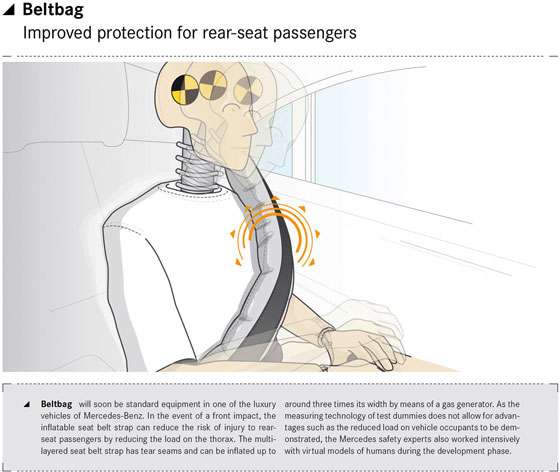A Mercedes-Benz pode ter sido pioneira em muitos equipamentos para carros, e na criação do próprio automóvel, no entanto, ela não foi a primeira a criar o airbag de cinto de segurança. Os créditos vão para o Ford Explorer e o Lexus LFA. Mas de uma coisa a Mercedes-Benz pode se orgulhar: ela criou o primeiro airbag de cinto de segurança... que só dispara em impactos frontais.
Chamado Beltbag, ele pode estar na próxima versão do Classe S, na metade de 2013, para logo após equipar vários outros modelos da marca. Como no sistema da Ford, o Beltbag só está disponível para os passageiros dos bancos traseiros, e infla o cinto de modo que ele fique com o triplo do seu tamanho normal, para que a área de contato com o corpo do passageiro seja melhor distribuída, diminuindo assim a chance de ferimentos causados pelo item de segurança.
Uma diferença para o sistema pioneiro da Ford é que o Beltbag só é acionado em colisões frontais, enquanto que o sistema do Explorer dispara em impactos na frente e nas laterais do veículo.
Stuttgart. The Beltbag, one of the highlights from the ESF 2009 Experimental Safety Vehicle, is due to go into production in a luxury-class model from Mercedes-Benz. The inflatable seat-belt strap is able to reduce the risk of injury to passengers in the rear in a head-on collision by lessening the strain placed on the ribcage.
Should the crash sensors detect a severe frontal impact, the airbag control unit will trigger deployment and inflation of the Beltbag. A gas generator then inflates the multi-layered belt strap with Velcro seams to nearly three times its normal width. The resulting larger surface area is able to better distribute the force acting on the seat occupant, thereby reducing the risk of injury.
The Beltbag can be used in exactly the same way as a conventional seat belt. The belt strap's design is different from that of the standard belt though, and received top marks in practical trials for being extremely comfortable to wear and for its extra-soft belt strap edge.
"Mercedes-Benz is pursuing its safety initiative in the rear of vehicles with the Beltbag," comments Prof. Dr.-Ing. Rodolfo Schöneburg, Head of Passive Safety and Vehicle Functions at Mercedes-Benz Cars. "After all, the excellent standard of safety offered by Mercedes-Benz doesn't just apply to all model series, but to all seats, too."
Just like the active seat-belt buckle recently presented by Mercedes-Benz that is likewise earmarked for inclusion in a luxury model, the Beltbag was developed with a particular view toward new markets. There, the occupancy rate in the rear is as much as 30 percent, making it much higher than in Europe. By introducing the Beltbag, Mercedes-Benz is further expanding the safety system for passengers in the rear – in contrast to many other manufacturers, seat belts in the second row of Mercedes-Benz models already come equipped with belt tensioners and belt force limiters. It is not planned to introduce the Beltbag for the front occupants, as airbags are already included in the front on all models as a supplementary restraint system.
Because dummy measurement technology is not capable of quantifying the benefits resulting from a wider belt strap, such as the lower force exerted on occupants, the safety experts at Mercedes have also been working intensely with virtual human models, as such computer-generated models make it possible to obtain detailed findings on the biomechanical strain during a collision.
Beltbag: o airbag de cinto de segurança da Mercedes-Benz
Tags:
Carros,
Mercedes-Benz
Publicado: domingo, 22 de julho de 2012 às 08:30
Permalink:
Copiar
Link copiado para a área de transferência!
Houve um erro ao copiar o link para a área de transferência.
Assinar:
Postar comentários (Atom)


Postar um comentário